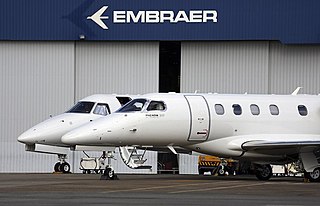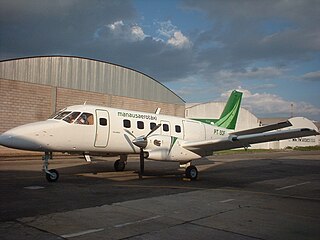Solomon Airlines is the national airline of Solomon Islands, based in Honiara.

Embraer S.A. is a Brazilian multinational aerospace corporation. It designs, manufactures, and sells commercial, military, executive, and agricultural aircraft, as well as provides leasing and aviation support services. Embraer is the third largest producer of civil aircraft after Boeing and Airbus. It is also among the world's top 100 defense contractors. The company is headquartered in São José dos Campos, São Paulo.

Alas Chiricanas Flight 00901, registered HP-1202AC, was an Embraer EMB 110 Bandeirante aircraft flying en route from Colón city to Panama City which exploded shortly after departing Enrique Adolfo Jiménez Airport, on the night of July 19, 1994. All 21 on board were killed in the bombing. Twelve of the victims were Jewish. Both Panamanian and American authorities consider the bombing an unsolved crime and an act of terrorism.
This is a list of aviation-related events from 1997.

Air Fiji was an airline based in Nausori, Fiji. It operated inter-island services to destinations within the Fijian Islands. Its main base was Nausori International Airport, Suva, with a base at Nadi International Airport.

The Embraer EMB 120 Brasilia is a twin-turboprop 30-passenger commuter airliner designed and manufactured by the Brazilian aircraft manufacturer Embraer.

The Embraer EMB 110 Bandeirante is a Brazilian twin-turboprop light transport aircraft designed by Embraer for military and civil use.

The Embraer EMB 121 Xingu is a twin-turboprop fixed-wing aircraft built by the Brazilian aircraft manufacturer, Embraer. The design is based on the EMB 110 Bandeirante, using its wing and engine design merged with an all-new fuselage. The EMB 121 first flew on 10 October 1976.

Rio-Sul Serviços Aéreos Regionais S/A was a regional airline headquartered in Rio de Janeiro, Brazil, operating scheduled services to southern Brazil. Its main base was São Paulo–Congonhas Airport, with hubs at Porto Alegre Airport and Santos Dumont Airport.

Total Linhas Aéreas is an airline based in Curitiba, Brazil, founded in 1988. It operates cargo and charter services. According to the National Civil Aviation Agency of Brazil (ANAC), between January and December 2023, Total Linhas Aéreas carried 1,347 passengers on charter flights and had 0.1% of the domestic market share in terms of revenue passenger kilometers (RPK), making it the tenth largest domestic airline, while transporting 21.1 thousand tons of cargo and had 6.4% of the domestic market share in terms of revenue tonne kilometer (RTK), making it the fourth largest cargo airline in Brazil.

Atlantic Southeast Airlines Flight 529 was an Embraer EMB 120 Brasilia aircraft that crashed in the community of Burwell between the cities Bowdon, Georgia and Carrollton, Georgia, on August 21, 1995. Nine of the 29 passengers and crew on board were killed as a result of the accident. The accident bore similarities to Atlantic Southeast Airlines Flight 2311, which had occurred four years earlier, and resulted in the deaths of all 23 people on board. The inquiries of both crashes concluded that design flaws in the aircraft's propellers were to blame.

The Embraer EMB 312 Tucano is a low-wing, tandem-seat, single-turboprop, basic trainer and counter-insurgency aircraft that was developed in Brazil. The Brazilian Air Force sponsored the EMB-312 project at the end of 1978. Design and development work began in 1979 on a low-cost, relatively simple, new basic trainer with innovative features which eventually became the international standard for basic training aircraft. The prototype first flew in 1980, and initial production units were delivered in 1983.

Continental Express Flight 2574 was a scheduled domestic passenger airline flight operated by Britt Airways from Laredo International Airport in Laredo, Texas to Houston Intercontinental Airport (IAH) in Houston, Texas. On September 11, 1991, the Embraer EMB 120 Brasilia turboprop, registered N33701, crashed while initiating its landing sequence, killing all 14 people on board. The aircraft wreckage hit an area near Eagle Lake, Texas, approximately 65 miles (105 km) west-southwest of the airport.
Pacific Island Air is an Air Charter company operating out of Nadi International Airport, Fiji.

The crash of an Embraer EMB-110P1 Bandeirante owned and operated by Manaus Aerotáxi occurred in the state of Amazonas in Brazil on February 7, 2009. At 13:50 local time, a Manaus Aerotáxi Embraer EMB-110P1 Bandeirante twin turboprop, registration PT-SEA, operating as an air taxi flight from Coari (SWKO) to Manaus (SBEG), crashed into the Manacapuru River about 80 kilometers (50 mi) southwest of its destination, killing the two crew and 22 of the 26 passengers on board. The four surviving passengers, who were seated in the rear, managed to escape the sinking plane and swim safely to shore. Among the passengers were eight small children of whom one survived, and a family of 17, two of whom survived.

Provincetown-Boston Airlines Flight 1039 was a scheduled passenger flight from Jacksonville International Airport in Jacksonville, Florida, to Tampa International Airport, Florida. On December 6, 1984, the plane crashed upon takeoff at Jacksonville, killing all 13 passengers and crew.

TABA – Transportes Aéreos Regionais da Bacia Amazônica was a Brazilian airline founded in 1976. It ceased operations in 1999.

The Civil Aviation Authority of Fiji (CAAF) is the civil aviation authority in the Republic of Fiji and is responsible for discharging functions on behalf of the Government of Fiji under the States responsibility to the Convention on International Civil Aviation, also known as the Chicago Convention on International Civil Aviation Organization (ICAO). CAAF regulates the activities of airport operators, air traffic control and air navigation service providers, airline operators, pilots and air traffic controllers, aircraft engineers, technicians, airports, airline contracting organisations and international air cargo operators in Fiji.

On 31 July 2015, an Embraer Phenom 300 business jet crashed into a car park next to Blackbushe Airport in Hampshire, United Kingdom, while attempting to land. The sole pilot and all three passengers on board were killed. The three passengers were members of the bin Laden family.

CommutAir Flight 4933 was a domestic regional flight operating from Newark, New Jersey, to Presque Isle, Maine, in the United States. The flight was operated by CommutAir under the United Express brand. On March 4, 2019, the Embraer EMB-145XR operating the flight touched down in a snow-covered grassy area to the right of the runway at Presque Isle International Airport, injuring three aircraft occupants and substantially damaging the aircraft. The accident was attributed to confirmation bias which prompted the flight crew to continue descending even though they could not see the runway due to snow; poor decision-making by the captain, fatigue of the first officer, and problems with the airport's instrument landing system were identified as contributing factors.

















